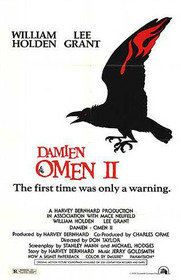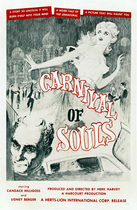Our editor-in-chief Nate Yapp is proud to have contributed to the new book Hidden Horror: A Celebration of 101 Underrated and Overlooked Fright Flicks, edited by Aaron Christensen. Another contributors include Anthony Timpone, B.J. Colangelo, Dave Alexander, Classic-Horror.com's own Robert C. Ring and John W. Bowen. Pick up a copy today from Amazon.com!
Damien: Omen II (1978)
In 1978, 20th Century Fox looked to recreate the box-office success that it found with 1976’s The Omen by producing a sequel, Damien: Omen II using many of the same components: a supernatural and suspenseful tale of the Devil’s son, Oscar-nominated actors, and the music of Jerry Goldsmith. Behind such a solid and substantiated formula (the original film grossed $60 million in the U.S.), Damien: Omen II is ultimately not quite able to live up to its own expectations, due to the plot being filled with unanswered questions and overly obvious foreshadowing techniques. It is, however, supported with the aforementioned score from Goldsmith (as spot-on as ever) and an honest performance from newcomer Jonathan Scott-Taylor.
Seven years have passed since the events of the first film and a thirteen-year-old Damien (Jonathan Scott-Taylor) is living with his father’s brother, Richard (William Holden, Network), his wife, Ann (Lee Grant, Voyage of the Damned) and their son, Mark (Lucas Donat). There are some around Damien that can sense his devilish relations, including Aunt Marion (Sylvia Sidney, Beetlejuice), a journalist named Joan Hart (Elizabeth Shepard), and a drill instructor, Sgt. Neff (Lance Henriksen, Pumpkinhead) at the military academy where Damien and Mark are enrolled. It’s just too bad not everyone that fears the true heritage of Damien survives long enough to reveal the truth.
There are several questions that could be asked at this point, the first and foremost being how long did Aunt Marion know about Damien’s past and just why the hell did she wait so long to open her mouth? From her obvious malign looks as Damien approaches her in the first few minutes of the film, it’s obvious that she knows more about him than he suspects, so how come her revelation about Damien’s past didn’t come at a more opportune time, perhaps when Damien was first considered to live there? Furthermore, how do the other characters in the film, like Sgt. Neff, know about Damien’s true identity as the devil’s son? Those familiar with the series will know that Damien bears a birthmark that is a dead giveaway to his lineage, so did these characters see this birthmark and come to their conclusions that way? If so, the film doesn’t show it, and this leaves the plot gaping with holes from unanswered questions.
Here’s another question to consider: remember that scene in the original Omen where Damien’s nanny hung herself at Damien’s birthday party and no one (including the audience) saw it coming? Damien: Omen II is devoid of scenes such as this classic one because of the use of heavy foreshadowing, piled on so thick by screenwriter Harvey Bernhard that the audience is practically drowning in it by the time something dramatic does happen. Each set up is written and executed the same way throughout the film, with a black crow appearing beside the doomed character just before said character experiences an overly drawn-out “accidental” death. It becomes clear to the audience early on that this is the routine that the film will follow in disposing its characters, and soon it becomes just that, a routine. Instead of being pulled along with the characters, the audience seems to remain ahead of them, knowing the when and where of their deaths.
But what the audience doesn’t know is how the characters will be brought to their grim fates and it is in these over-the-top death sequences — delivered at a breakneck pace thanks to director Don Taylor — that Damien: Omen II manages to excel slightly beyond its predecessor. It is a more violent sequel to be sure and gore enthusiasts will find reason to celebrate the overabundance of blood-soaked character finales, including one that involves a broken elevator cable and the unfortunate scientist who finds himself on the floor of the elevator just as the cable slices through. Darn, he was just going to reveal Damien’s secret, too! Taylor chooses to keep his camera on these deaths just a little too long at times, resulting in exaggerated deaths that become more comical each second (reporter Joan Hart fighting off a crow comes to mind). The fatalities in Damien: Omen II are all certainly absurd, but there is no denying their ability to deliver in the end. Some of them even come close to rivaling the beheading of the photographer in the original.
Contributing to these fantastic death sequences even further is the outstanding score from Jerry Goldsmith, whose work on the original The Omen won him the first (and only) Oscar of his illustrious career. Goldsmith decided against using the same musical cues from The Omen (the main theme, “Ava Santani” is used sparingly here) instead opting for a score that calls to mind his Oscar-winning work. His use of Latin phrases evokes images of the Bible, one of most crucial elements to the entire series, though here the chanting of these phrases is heavily masked with the use of heavy string instruments and the occasional violin, creating a soft but brash sound. This score is well-timed on the screen as well, swooping in just as the ominous actions on screen build (usually leading to an untimely death) and ceasing just after the action reaches its gruesome climax.
At the forefront of these pivotal moments in the film is Damien, and it is Scott-Taylor’s performance as the teenage Antichrist that sustains Damien: Omen II as an important part of the Omen series. It is in this film that Damien learns of his past as the son of the Devil and his role as the future leader of the world. Damien’s emotional range must therefore fluctuate quite frequently throughout the film as the teenager must choose to accept or deny his own fate, and Scott-Taylor’s portrayal is ever-so complicated during these tumultuous times. Much of Scott-Taylor’s acting in the role is exerted through his eyes. In earlier scenes, the actor gives Damien an almost wide-eyed innocence; in later scenes, like the one in which Damien is reading the Bible and discovering his heritage, the actor’s eyes are bouncing around his head like a pinball. This is also true of Scott-Taylor’s vocal contributions to the role of Damien: a sweet-sounding, almost feminine tone radiates from the character early in the film while agonizing screams bellow from within him in the later half as he learns of what he must do to secure his fate (including kill all of those that he loves).
In terms of context, Damien: Omen II provides ample breathing room for the Damien character to further grow (in sequels and other various incarnations) and the performance of Jonathan Scott-Taylor is what truly allows Damien to shed his childhood innocence and develop seething teenage angst (which will be explored further by other actors in other sequels to come). Enough cannot be said about Goldsmith’s score or Taylor’s pacing for providing fodder for a bloodthirsty audience. Unfortunately the script leaves several wavering questions unanswered and is weighed with heavy foreshadowing that becomes too much of a routine. Damien: Omen II is not the landmark film of its predecessor, nor can it stand beside it as an equal film. It can, however, stand amongst other deserving sequels in
(Editor’s note: Just as the writer was going to deliver this message of praise, an elevator cable came down from the heavens and sliced him in two.)








